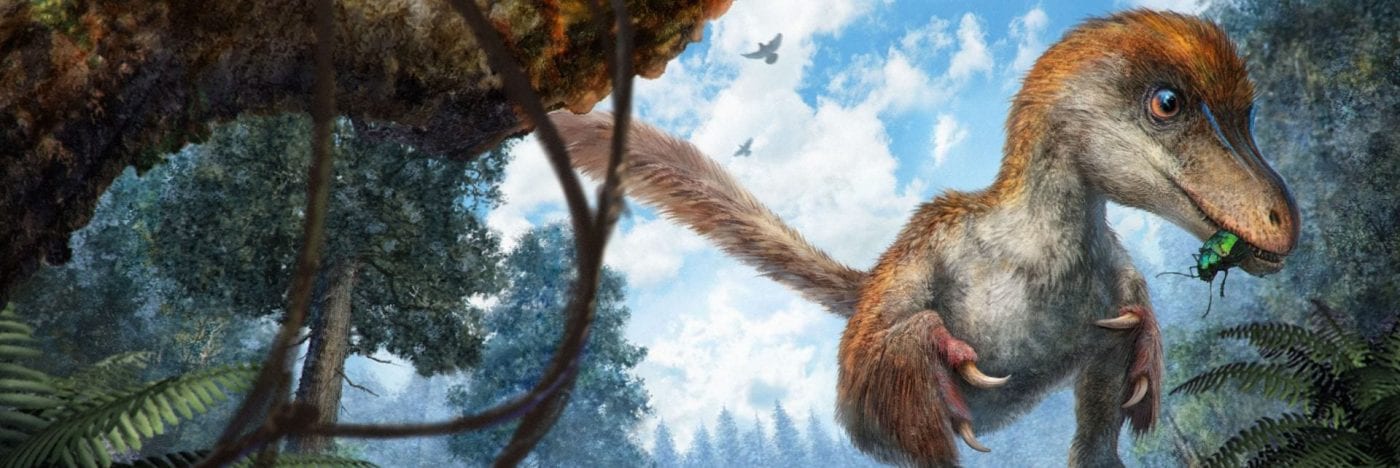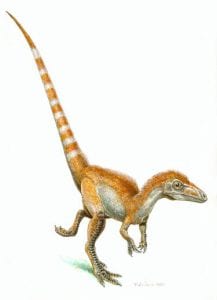First reports of dinosaur feathers
 When dinosaur feathers were first reported (Ji and Ji 1996; Chen et al. 1998; Ji et al. 1998), many palaeontologists were appalled. Only birds have feathers, they said, and to claim to see feathers in a dinosaur is madness! Critics argued that the early specimens from China were really birds that had been mistaken for dinosaurs, or that they were fakes, cleverly built up from bits of genuine fossil bird specimens with feathers and isolated dinosaur bones, or that the so-called ‘feathers’ were shredded skin.
When dinosaur feathers were first reported (Ji and Ji 1996; Chen et al. 1998; Ji et al. 1998), many palaeontologists were appalled. Only birds have feathers, they said, and to claim to see feathers in a dinosaur is madness! Critics argued that the early specimens from China were really birds that had been mistaken for dinosaurs, or that they were fakes, cleverly built up from bits of genuine fossil bird specimens with feathers and isolated dinosaur bones, or that the so-called ‘feathers’ were shredded skin.
[Right] The type specimen of Sinosauropteryx (NIGP 127586), named in 1996. Note the crest of so-called ‘protofeathers’ down the back of the head, neck and back, and the dark and light tufts along the tail.
However, doubters have investigated the specimens and they are real. One of the first was Sinosauropteryx, based on a spectacular slab (right). This dinosaur, a close relative of Compsognathus from Germany, and some distance down the evolutionary tree from the origin of birds, possesses simple monofilaments – bristle-like hairs. Since 1996, thousands of specimens of dinosaurs from many geological ages and many localities have been reported from China, and the majority are well enough preserved to show feathers. Further, many of these dinosaurs, all belonging to known theropod groups such as tyrannosauroids, therizinosaurs, oviraptorosaurs, dromaeosaurids, and troodontids, possess more than simple monofilaments, but a whole array of feathers as seen in modern birds, as well as some that are apparently known only from dinosaurs and primitive birds.
Later study of the Sinosauropteryx specimens showed further evidence of the colour distribution, highlighting warning and camouflage colouration.
All kinds of feathers
Modern birds have seven kinds of feathers, but dinosaurs had these and many more.
 At first, palaeontologists could classify the feathers they found in the dinosaurs and fossil birds into these modern types. Then they found other types that could not be matched in living birds. For example, the ribbon-like feathers of the oviraptorosaur theropod dinosaur Similicaudipteryx from the Early Cretaceous of China (Xu et al. 2010) were entirely unexpected, consisting of an elongate ribbon-like rachis with a pennaceous tip, comprising neatly organised, radiating barbs. Similar ribbon feathers are known in some basal birds, especially in the tail, and they may have mainly operated as display structures that could be erected and rattled.
At first, palaeontologists could classify the feathers they found in the dinosaurs and fossil birds into these modern types. Then they found other types that could not be matched in living birds. For example, the ribbon-like feathers of the oviraptorosaur theropod dinosaur Similicaudipteryx from the Early Cretaceous of China (Xu et al. 2010) were entirely unexpected, consisting of an elongate ribbon-like rachis with a pennaceous tip, comprising neatly organised, radiating barbs. Similar ribbon feathers are known in some basal birds, especially in the tail, and they may have mainly operated as display structures that could be erected and rattled.
[Left] Ribbon-like feathers with expanded tips, seen in the oviraptorosaurian theropod Similicaudipteryx (a), an unnamed maniraptoran (b), an enantiornithine bird (c), and a confuciusornithid bird (d). Image from Xu et al. (2010)
More widely among dinosaurs, other kinds of bristles and multiply branching feathers have been noted. For example, the ornithischian Psittacosaurus sports a ‘fence’ of about 100 cylindrical bristles along the midline of its tail. The heterodontosaurid ornithischian Tianyulong also has bristles along its back. Most dramatically, the Middle Jurassic ornithopod Kulindadromeus from Siberia shows a great range of feathers and scales of all sizes, including numerous feathers comprising basal plates like scales and with six or seven slender streamers sprouting backwards.
Melanosomes in Jehol dinosaur feathers
Following the discovery of eumelanosomes in the feathers of birds from Crato in Brazil (Early Cretaceous), the Fur Formation in Denmark (Eocene), and Messel in Germany (Eocene) by Vinther et al. (2008), Zhang et al. (2010) identified both eumelanosomes and phaeomelanosomes in isolated feathers and in bird and dinosaur feathers from the Early Cretaceous Jehol Group in China .
The integumentary filaments of the compsognathid dinosaur Sinosauropteryx (above) and the dromaeosaurid dinosaur Sinornithosaurus (below) show a range of melanosome shapes, as in the Jehol birds and the birds from Messel and other sites. Further, these melanosomes are arranged within the remains of the fundamental keratin matrix of the dinosaurian filamentous appendages, just as they are in the pennaceous feathers of dinosaurs and of birds.
 Melanosomes in the integumentary filaments of the dinosaur Sinornithosaurus (IVPP V12811). a, Optical photographs of part of the holotype and SEM samples (insets). b, Mouldic phaeomelanosomes. c, Aligned eumelanosomes preserved as solid bodies. d, Strongly aligned mouldic eumelanosomes. Scale bars: a, main panel, 50 mm and inset, 10 mm; b-d, 2 µm.
Melanosomes in the integumentary filaments of the dinosaur Sinornithosaurus (IVPP V12811). a, Optical photographs of part of the holotype and SEM samples (insets). b, Mouldic phaeomelanosomes. c, Aligned eumelanosomes preserved as solid bodies. d, Strongly aligned mouldic eumelanosomes. Scale bars: a, main panel, 50 mm and inset, 10 mm; b-d, 2 µm.
The Jehol dinosaurs show both eumelanosomes and phaeomelanosomes, sometimes both in the same feather, but more commonly just one or the other. A striking finding was that the filamentous feathers from the bands on the tail of Sinosauropteryx preserve only phaeomelanosomes. These findings can tell us the colour of the dinosaur feathers.
Dinosaur colour!
Two papers in 2010 presented evidence for the colour of dinosaurs (Li et al. 2010; Zhang et al. 2010). The teams had each worked on a different dinosaur, Zhang et al. (2010) on Sinosauropteryx from the Early Cretaceous Jehol Group, and Li et al. (2010) on Anchiornis from the Late Jurassic Tiaojishan Formation, both from Liaoning Province, NE China. Both teams used the same microscopic techniques to identify melanosomes in the fossilized feathers and to interpret them, according to shape and packing in the feather, as evidence for a variety of melanin-based colours, including black, brown, grey, and ginger.
The melanosome types, whether eumelanosomes or phaeomelanosomes, give a broad indication of colour, but these inferences may not always be absolutely correct. Many extant vertebrates combine melanosomes with other pigments in their integumentary tissues that modify the visible colour. Experiments on feathers have shown that during diagenesis, however, non-melanin pigments (and photonic structures) are destroyed, and only melanosomes remain (McNamara et al. 2013). Thus fossil melanosome distributions are probably best used to infer broad patterns rather than precise hue.
Speculation becomes science. These are the first ever true-to-life colour images of dinosaurs. Before 2010, the colour of dinosaurs was simply guesswork. After 2010, for feathered dinosaurs at least, the colours can be tested and demonstrated based on evidence. Image credits: Sinosauropteryx (left) courtesy of Jim Robins (Bath); Anchiornis (right) courtesy of Michael DiGregorio (Yale).
It should be noted that the fact that the ‘protofeathers’ of Sinosauropteryx contained melanosomes was good evidence that these monofilaments were feathers and not shredded skin. Further, it was interesting, and unexpected, that both teams (Li et al. 2010; Zhang et al. 2010), working on different dinosaurs located in different parts of the theropod evolutionary tree, both found that dinosaur colour was not uniform, but was in fact richly patterned. Sinosauropteryx had a barber-pole tail of neat ginger and white bands of colour, while Anchiornis showed sharp black and white bars on its wings, a ginger-coloured head crest, and specks of ginger on its black-coloured cheeks.
Dinosaur feathers showed sharp patterns which could have been for camouflage, but that seems unlikely as the patterns did not cover the whole body (e.g. stripes on tiger or zebra), and so probably functioned in display. Perhaps these small dinosaurs hopped about, flashing their wings and tails for display purposes, either to scare away predators or to show off to potential mates. In the evolution of feather function, this means that feathers evolved first for insulation and later became adapted for flight, as had long been understood, but perhaps the display function emerged much earlier in evolution than anyone might have suggested before.
References
- Benton, M.J., Zhou Z., Orr, P.J., Zhang F., & Kearns, S.L. 2008. The remarkable fossils from the Early Cretaceous Jehol Biota of China and how they have changed our knowledge of Mesozoic life. Proceedings of the Geologists’ Association 119, 209-228. Download the paper here
- Chen, P.J., Dong, Z.M. and Zhen, S.N. (1998) An exceptionally well-preserved theropod dinosaur from the Yixian Formation of China. Nature 391, 147–152.
- Ji, Q., Currie, P.J., Norell, M.A. and Ji, S. (1998) Two feathered dinosaurs from northeastern China. Nature 393, 753–761.
- Ji, Q. and Ji, S. 1996. On the discovery of the earliest bird fossil in China (Sinosauropteryx gen. nov.) and the origin of birds. Chinese Geology 10, 30–33.
- Li, Q., Gao, K.-q., Vinther, J., Shawkey, M.D., Clarke, J.A., D’Alba, L., Meng, Q., Briggs, D. E. G., Miao, L., and Prum, R.O. 2010. Plumage color patterns of an extinct dinosaur. Science 327, 1369-1372.
- McNamara, M.E., Briggs, D.E.G., Orr, P.J., Field, D.J. et al. 2013. Experimental maturation of feathers: implications for reconstructions of fossil feather colour. Biology Letters 9, 1–6.
- Vinther, J., Briggs, D.E.G., Prum, R.O. & Saranathan, V. 2008. The colour of fossil feathers. Biology Letters 4, 522-525.
- Xu, X., Zheng, X. and You, H. 2010. Exceptional dinosaur fossils show ontogenetic development of early feathers. Nature 464, 1338–1341.
- Zhang, F., Kearns, S.L, Orr, P.J., Benton, M.J., Zhou, Z., Johnson, D., Xu, X., and Wang, X. 2010. Fossilized melanosomes and the colour of Cretaceous dinosaurs and birds. Nature 463, 1075-1078. Download the paper here and the Supplementary data.
Videos
A great video, from Discovery, showing dinosaurs using their feather colours in all kinds of display behaviour.




